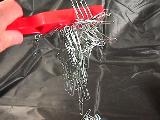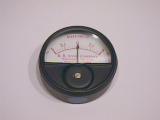


Experiments with magnets and our surroundings
How strong are magnets?
Typical Values
Here is a list of how strong some magnetic fields can be:
| Smallest value in a magnetically shielded room | 10^-14 Tesla | 10^-10 Gauss |
| Interstellar space | 10^-10 Tesla | 10^-6 Gauss |
| Earth's magnetic field | 0.00005 Tesla | 0.5 Gauss |
| Small bar magnet | 0.01 Tesla | 100 Gauss |
| Within a sunspot | 0.15 Tesla | 1500 Gauss |
| Small NIB magnet | 0.2 Tesla | 2000 Gauss |
| Big electromagnet | 1.5 Tesla | 15,000 Gauss |
| Strong lab magnet | 10 Tesla | 100,000 Gauss |
| Surface of neutron star | 100,000,000 Tesla | 10^12 Gauss |
| Magstar | 100,000,000,000 Tesla | 10^15 Gauss |
What is a Tesla? It is a unit of
magnetic flux density. It is also equivalent to these other units:
1 Weber per square meter
10,000 Gauss (10 kilogauss)
10,000 magnetic field lines
per square centimeter
65,000 magnetic field lines
per square inch.
Now, 1Gauss is about 6.5 magnetic field lines per square inch.
If you place the tip of your index finger to the tip of your thumb, enclosing approximately 1 square inch, four magnetic field lines would pass through that hole due to the earth's magnetic field!
Measuring the strength of magnets
1. Hall-Effect Devices
A Hall-effect device is a piece of material which is affected by a magnetic field. By passing a constant amount of current through it in one direction, and by placing it in a magnetic field in another direction, we can measure a voltage across it in the third direction. This voltage is proportional to the strength of the magnetic field. This can be calibrated to provide a certain mV change for every Gauss of magnetic field. This effect was discovered by Edwin Hall in 1917. The materials often used today in these devices are indium arsenide or gallium arsenide. There are also superconducting devices which can measure minute magnetic fields, called SQUIDS.

What can you do with a Hall-effect device? Build an electronic circuit which will amplify the voltage across the device and calibrate it so you can measure a voltage and translate that into a Gauss measurement. For such a unit, check out the page on building a Gaussmeter.
2. Paper clips and BB's ![]()


If you don't have a way to build a gaussmeter or magnetometer
in order to measure the strength of the magnetic flux density of a magnet, then
what else could you do? Try this.
1. Count how many paperclips or staples you can
attach end to end from the north pole to the south pole.
2. Count how many paperclips or staples you can
attach to one of the magnet's poles.
3. Have a big pile of paperclips or staples on
the table and count how many will stick to the magnet, all over its surface.
4. Have a big pile of small (1 to 4mm in
diameter, or 1/32 to 1/8" diameter) steel ball bearings or BB's in a
plastic container, and count how many will stick to the magnet after you place
the magnet into the middle of the pile and try to completely cover it with the
BB's. Remove the magnet all covered with BB's, and take it to another
plastic container to pull off and count the number of BB's that the magnet was
able to attract to itself.
3. Magnetometer

This is a meter my brother had purchased in order to insure there was no residual magnetic field left on some equipment. It would show polarity and magnitude. It was made by Anno Instruments in Indianapolis. It is very sensitive. The area at the bottom of the meter is placed near the magnetic field to be measured.
What appears to be a good book on this subject is:
The Magnetic Measurements Handbook,
by J.M. Janicke
Magnetic Research, Inc.
Two rods
It is fairly easy to determine which rod is a
magnet and which is not. I suspect that if you actually had those two rods
in front of you, you would be able to figure it out. Here's a
straightforward method to determine that.
Let's call one rod A and the other rod B. (Perhaps you could keep one in the
left hand and the other in the right hand).
Next, touch the end of A to the middle of B.
If it sticks, then A is the magnet
and B is iron.
If it does not stick, then B is the
magnet and A is iron.
To double check this, touch the end of B to the middle of A.
If it sticks, then B is the magnet
and A is iron.
If it does not stick, then A is the
magnet and B is iron.
Why does this work?
In the center between the poles of a magnet, there is very
little magnetic field or flux outside the magnet. All of the flux is
inside the magnet itself. Because of this, iron is weakly attracted to the
middle of the magnet if at all. However, the end or pole of a magnet will
easily stick to any part of an iron rod.
Three rods
The solution to this is similar to the one above, but it just requires a little
more work.
Let's call one rod A, one rod B, and the last rod C. Have them lined up on
the floor in that sequence.
First, touch the end of A to the middle of B.
If it sticks, then A is the magnet, B
is iron, and C is brass.
If it does not stick, continue.
Next, touch the end of A to the middle of C.
If it sticks, then A is the magnet, C
is iron, and B is brass.
If it does not stick, continue.
Next, touch the end of B to the middle of A.
If it sticks, then B is the magnet, A
is iron, and C is brass.
If it does not stick, continue.
Next, touch the end of B to the middle of C.
If it sticks, then B is the magnet, C
is iron, and A is brass.
If it does not stick, continue.
Next, touch the end of C to the middle of A.
If it sticks, then C is the magnet, A
is iron, and B is brass.
If it does not stick, continue.
Lastly, touch the end of C to the middle of B.
If it sticks, then C is the magnet, B
is iron, and A is brass.
If it does not stick, something is
wrong and you should try it all again.
Why does this work?
In the center between the
poles of a magnet, there is very little magnetic field or flux outside the
magnet. All of the flux is inside the magnet itself. Because
of this, iron is weakly attracted to the middle of the magnet if at all.
However, the end or pole of a magnet will easily stick to any part of an iron
rod. Also, brass is not attracted to a magnet, so it will never stick to a
magnet.